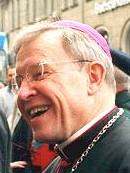
«Første punkt er at Jesus Kristus ønsket bare én eneste kirke, og det er derfor vår trosbekjennelse bekjenner troen på una sancta catholica et apostolica ecclesia.. Akkurat som vi bekjenner troen på én Gud og på én forløser Jesus Ktistus, og på én Ånd og på én dåp, slik bekjenner vi også troen på én Kirke.
Dette skriver kardinal Walter Kasper i boken Leadership in the Church, som kom for ut noen få år siden. Fortsettelsen av dette første punktet kommer her, og deretter punkt to og tre: We do not regard this oneness as something lying only in the future, the result of our ecumenical endeavors; it does not only exist at present in the fragments of seperated churches, but ‘subsists’ in the Roman Catholic Church. In other words, despite all the weakness of the Roman Catholic Church, God’s faithfulness preserves the one church in it: this is the concrete location of the one church.
Second, the one church of Jesus Christ exists ‘in and out of’ local churches, since the one church of Jesus Christ is present in every local church, especially in every celebration of the Eucharist. Since, however, the one Lord Jesus Christ is present in every local church, none can exist in isolation: it can survive only in fellowship with all the other local churches. Just as the universal church exists ‘in and out of’ local churches, so too every individual church exists ‘in and out of’ the one church of Jesus Christ. The church’s unity is a communio-unity, which excludes egotism and national autonomy on the part of any local church. The local church includes the universal church, and the universal church includes the local church.
Third, just as the local churches are not branches or provinces of the universal church, so the universal church is not the sum or product of a combination of local churches. The local church and the universal church inhere in each other; their relationship is one of compenetration or circumincession. The church is neither a federal nor a unitary state; it has a constitution of its own that cannot be adequately grasped by any sociological analysis. Ultimately, its unity is a mystery, since its archetype is the Trinity of the one God in three Persons. This is why unity does not mean uniformity; the unity of the church does not exclude plurality, but rather includes it.»
Sitater er hentet fra bloggen Evangelical Catholicism.
